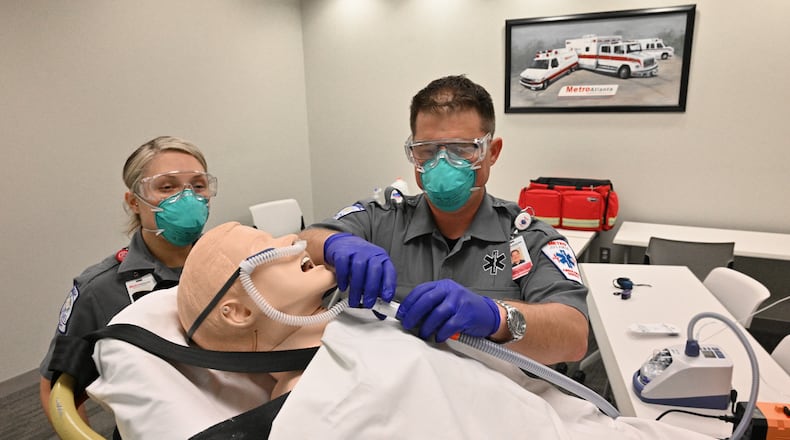Over three decades, paramedic Jamey Crosby bolted all over Georgia in the back of an ambulance, lights and sirens blazing, going from one emergency to the next.
On every ride, he was equipped with medicines and equipment he relied on to save lives. Now, Crosby has a revolutionary tool at his fingertips: an iPad that enables a virtual emergency room to pop up in a patient’s home.
After he collects vital information about the patient, he shares it in real-time with a physician who appears on the screen. Crosby can use his stethoscope to let the physician listen to the patient’s breathing, and the iPad allows the physician to peer into the patient’s mouth.
“If the doctor needs some other kind of assessment done, he can tell us to do that and we can give him our findings,” said Crosby, now director of performance and compliance at Gold Cross EMS in Augusta.
For years, despite the medical services they provide, Georgia EMS crews often have been considered as little more than drivers who provide a swift ride to the hospital. But with the heavy burden COVID-19 placed on health care systems, EMS has been called on to relieve some of the load. Ambulance crews have had to be trained and equipped to provide new treatments on site, to make crucial assessments on transporting patients and to support overwhelmed emergency departments.
The expanded role points to new delivery models for emergency medical services that are starting to emerge. Those models, such as the pilot program that Crosby is part of, recognize EMS as crucial front-line health care providers.
“It’s about making sure patients receive the right care at the right time in the right place,’' said Dr. Mark Gamber, EMS medical director for Envision Healthcare, a Nashville-based medical group that provides support to emergency rooms of hospitals across the U.S., including some in metro Atlanta.
Georgia may struggle to adapt such innovations, though, unless longstanding deficiencies in emergency care systems are addressed. The pandemic made the problems all too apparent.
Ambulance services that have perpetually struggled with staffing shortages were pushed to the breaking point as paramedics were exposed to COVID-19 or fell ill and ambulances were tied up for hours outside emergency departments.
The pandemic also laid bare the shoe-string budgets of some Georgia EMS systems, which are paid only when patients are taken to a hospital, not for care they provide at the scene.
“The pandemic is exposing some of the deficiencies in the way our system works,’' said Steve Vincent, vice president of Gold Cross EMS.
“EMS services already run on very thin margins, and so now when you’re asking us to take on all these additional tasks, doing more for patients, people are starting to realize that maybe EMS does a little bit more than they thought they did.”
Wide gaps
One major obstacle to transforming EMS is Georgia’s lack of skilled personnel, particularly paramedics, who can provide on-scene treatment before conditions become fatal.
The state was already at a crisis level in staffing before the pandemic, as educational standards ratcheted up but pay lagged. Georgia is among the states with the lowest pay for paramedics, at an average of $34,000 a year.
“EMS services already run on very thin margins, and so now when you're asking us to take on all these additional tasks, doing more for patients, people are starting to realize that maybe EMS does a little bit more than they thought they did."
Crews also suffer from high rates of depression and burnout, industry leaders say. And the profession has had one of the highest rates of injuries and illnesses of all occupations, according to the U.S. Bureau of Labor Statistics.
When the pandemic hit, the situation became more dire. Several providers, including fire departments where crews are cross-trained as EMTs, told the AJC that at least one-third of employees had to be quarantined over the last year because of a positive test or exposure to the virus.
“We’re all being exposed to COVID-19 at a higher rate,’' said Paul Gerdis, an Atlanta firefighter and member of the International Association of Fire Fighters, which maintains a database on first responders who have fallen ill or quarantined due to COVID-19.
The state attempted to overcome widespread staffing shortages by issuing emergency waivers that allow licensed medics from other states to ride on ambulances. Another emergency provision issued last year allows trucks to be staffed with a driver who isn’t a medic.
“As with all healthcare providers, EMS agencies have had to adapt to the realities of the pandemic,’' said David Newton, director of the Office of EMS and Trauma for the Georgia Department of Public Health.
Those emergency provisions do not solve underlying issues, though.
A financial hit
The pandemic also imposed a heavy financial burden on EMS agencies that was only partially eased by federal relief funding.
Ambulance services had to buy more medical equipment and supplies and train medics on how to use them.
After EMS crews early last year noticed the prevalence of patients in respiratory distress, providers began investing in high-flow nasal cannulas, which deliver more oxygen to patients. The early treatment could reduce their chances of ending up on a ventilator and, ultimately, increase their chances of survival.
Credit: Steve Schaefer
Credit: Steve Schaefer
Other agencies purchased matchbox-sized devices called portable pulse oximeters that can quickly determine if a patient is in respiratory distress, without crews having to unload larger equipment that has to be decontaminated after each use.
On-scene treatment costs also spiked as crews responded to calls for patients who are sicker than those they saw prior to the pandemic, said John Smith, a paramedic and senior director of operations for Gold Cross EMS. That’s because many people delayed medical care during the pandemic, leading to a surge of cases of stroke, cardiac arrest and complications from high blood pressure and diabetes.
“Where somebody might be about to have a heart attack, now it’s serious,” Smith said. “They’re either very sick or they’ve done damage to their heart.”
Providers also have taken a financial hit as patients asked to be treated in their homes or taken to urgent care clinics.
When shelter-in-place was ordered last spring, 911 transports to the hospital dropped by 26 percent in Savannah, said Chuck Kearns, chief executive officer of Chatham Emergency Services.
“A lot of people just called and wanted us to just check on them, and they didn’t want to go the hospital,’' Kearns said. “They just wanted to make sure they were not dying from whatever was affecting them.”
Priority Ambulance, one of the largest private ambulance agencies in Georgia, told the AJC between 5 to 8 percent of callers still don’t want to go to the hospital. As a result, the agency does not qualify for reimbursement for those calls from Medicare or Medicaid.
Adapting to change
There are moves now to change payment models and recognize the role of EMS in the health care system.
Gold Cross EMS is among about 200 ambulance providers participating in the pilot program launched Jan. 1 by the U.S. Centers for Medicare and Medicaid Services, which allows them to receive federal reimbursement for treating patients at home. The program also offers Medicare patients the option to be transported to an urgent care center or a doctor’s office, instead of an emergency room.
So far, Crosby and his crews have made nearly 1,000 calls under the program, “Emergency Triage, Treat and Transport,” or ET3.
“Up until the recent future, we’ve not had this option at all, so patients are very surprised,’' Crosby said.
In another move, the American Rescue Plan recently approved by Congress provides a way to allow Medicare to reimburse for ground ambulance services when a patient is treated in place during the pandemic.
“It is the first time that the transport requirement has been waived, and it is a strong indication that Congress truly considers ambulance service providers as frontline health care providers,’' said Tristan North, senior vice president of governmental affairs at the American Ambulance Association in Washington, D.C.
In another move, Georgia lawmakers are trying to increase Medicaid funding for ambulance services.
Both chambers of the General Assembly this month approved a bill that would authorize the Georgia Department of Community Affairs to assess fees on private EMS providers that would be used to match federal Medicaid payments for ambulance runs. Medicaid primarily covers ambulance services for the poor and people with disabilities.
The bill is awaiting consideration by Gov. Brian Kemp. Authorization was already in place for government and hospital-based ambulance providers, such as Grady EMS.
Ultimately, the changing role of EMS could actually lower overall health care costs by allocating resources more appropriately, said Gamber, the emergency room physician.
While paramedics will have to spend more time evaluating patients and having conversations with them and their families, the on-scene treatment saves on transport, especially in rural areas where ambulances travel long distances to hospitals. That means crews will be able to see more patients, Gamber said.
“It saves time and keeps first responders and ambulances available to respond to emergencies,’' he said.
Emergency waivers
During the pandemic, the Georgia Office of EMS and Trauma adopted a series of emergency rules to bolster the EMS workforce and meet other needs. These are highlights:
· Allowed for a single licensed medic and driver to transport patients in very limited circumstances;
· Offer multiple options for people to enter the EMS workforce, including those licensed in other states; those previously licensed in Georgia who retired or had licenses expire since 2017; and EMS program graduates who hadn’t yet passed required exams;
· Allowed EMS initial education students to assist in COVID-19 specimen collection sites and at COVID-19 vaccination sites across the state;
(Source: Georgia Department of Public Health, Office of EMS and Trauma)
About the Author
The Latest
Featured





